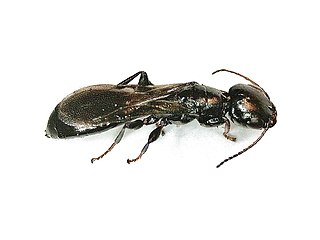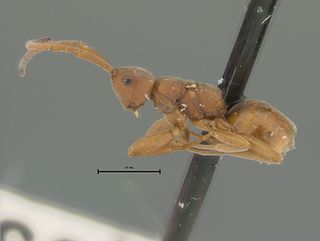
The Scoliidae, the scoliid wasps, are a family of wasps comprising about 560 species worldwide. They tend to be black, often marked with yellow or orange, and their wing tips are distinctively corrugated. Males are more slender and elongated than females, with significantly longer antennae, but the sexual dimorphism is not as apparent as in many of the Tiphiidae and Thynnidae.

Wasps in the family Pompilidae are commonly called spider wasps, spider-hunting wasps, or pompilid wasps. The family is cosmopolitan, with some 5,000 species in six subfamilies. Nearly all species are solitary, and most capture and paralyze prey, though members of the subfamily Ceropalinae are kleptoparasites of other pompilids, or ectoparasitoids of living spiders.

Polistes is a cosmopolitan genus of paper wasps and the only genus in the tribe Polistini. Vernacular names for the genus include umbrella wasps, coined by Walter Ebeling in 1975 to distinguish it from other types of paper wasp, in reference to the form of their nests, and umbrella paper wasps. Polistes is the single largest genus within the family Vespidae, with over 200 recognized species. Their innate preferences for nest-building sites leads them to commonly build nests on human habitation, where they can be very unwelcome; although generally not aggressive, they can be provoked into defending their nests. All species are predatory, and they may consume large numbers of caterpillars, in which respect they are generally considered beneficial.

The Chironomidae comprise a family of nematoceran flies with a global distribution. They are closely related to the Ceratopogonidae, Simuliidae, and Thaumaleidae. Many species superficially resemble mosquitoes, but they lack the wing scales and elongated mouthparts of the Culicidae.

Dryinidae is a cosmopolitan family of solitary wasps. Its name comes from the Greek drys for oak: Latreille named the type genus Dryinus because the first species was collected in an oak plant in Spain. The larvae are parasitoids of the nymphs and adults of Auchenorrhyncha. Dryinidae comprises approximately 1924 described species, distributed in 17 subfamilies and 54 genera.

Mischocyttarus is a very large, primarily Neotropical genus of social wasps with a few species found also in the Nearctic region. It is the only member of the tribe Mischocyttarini; the asymmetrical tarsal lobes of Mischocyttarus separates it from the tribe Epiponini. Mischocyttarus is the largest genus of social wasps, containing over 200 species and subspecies. Mischocyttarus wasps build a relatively simple, single comb nest. Sometimes, the nest is built within a meter of the nest of Polistes carnifex. Foraging adults bring nectar and small caterpillars back to the nest to feed to the developing larvae which are individually housed in separate cells in the nest. Not all nests have a female with developed ovaries. Their biology is similar to that of species in the genus Polistes. However, Mischocyttarus appear to show considerably more social and reproductive flexibility than Polistes.

Ropalidia is a large genus of eusocial paper wasps (Polistinae) in the tribe Ropalidiini distributed throughout the Afrotropical, Indomalayan and Australasian biogeographical regions. The genus Ropalidia is unusual because it contains both independent and swarm-founding species. Ropalidia romandi is one of the swarm founding species, meaning that new nests are founded by a large group of workers with a smaller number of inseminated females, while Ropalidia revolutionalis is independent-founding, meaning that each nest is founded by a single foundress.

The Doryctinae or doryctine wasps are a large subfamily of parasitoid wasps within the family Braconidae.

Andricus is a genus of oak gall wasps in the family Cynipidae.

Anteon is the largest genus in the subfamily Anteoninae of the family Dryinidae, it occurs globally and there is a current total of 464 species described. The species in the genus Anteon are parasitoids of leafhoppers from the family Cicadellidae. The female wasps of the family Dryinidae almost always possess a chelate protarsus, as do females of species within Anteon. The chelae are used to capture and immobilise the host leafhopper to allow the wasp to oviposit and feed on it.

The Bethylidae are a family of aculeate wasps in the superfamily Chrysidoidea. As a family, their biology ranges between parasitoid wasps and hunting wasps.

Gelechiinae is a subfamily of moths in the family Gelechiidae. It was described by Henry Tibbats Stainton in 1854.

The Thynnidae are a family of large, solitary wasps whose larvae are almost universally parasitoids of various beetle larvae, especially those in the superfamily Scarabaeoidea. Until recently, the constituents of this family were classified in the family Tiphiidae, but multiple studies have independently confirmed that thynnids are a separate lineage.

Telenomus is a genus of parasitoid wasps from the subfamily Telenominae. The genus was first described by Alexander Henry Haliday in 1833. Species in this genus parasitise the eggs or immature stages of other insects.

Embolemidae is a family of small solitary parasitoid wasps with around 70 species in 2 genera distributed around the world. The few species whose biology is known are parasites on planthopper nymphs of the families Achilidae and Cixiidae. There is debate regarding the status of the genus named Ampulicomorpha by Ashmead in 1893, generally considered now to be a junior synonym of Embolemus (e.g.,), though some authorities dispute this (e.g.,)
Gonatopus jacki is a species of small wasp in the family Dryinidae. It is found in United States.

Janetiella is a genus of gall midges in the family Cecidomyiidae. There are at least thirty described species.
A list of the species of Hymenoptera from New Zealand; which includes ants, bees, parasitoids, sawflies, and social wasps.

Evania is a genus of ensign wasps in the family Evaniidae. Like all members of the family, they are cockroach egg parasitoids. There are more than 60 described species in Evania. Evania appendigaster, the blue-eyed ensign wasp, is a common wasp found through most of the world.

Embolemus is a genus of wasps belonging to the family Embolemidae. There is debate regarding the status of the genus named Ampulicomorpha by Ashmead in 1893, generally considered now to be a junior synonym of Embolemus (e.g.,), as a few authorities dispute this (e.g.,).


















